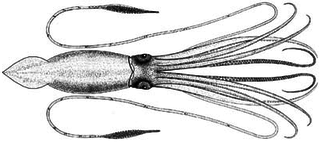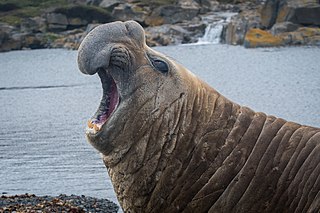
A squid is a mollusc with an elongated soft body, large eyes, eight arms, and two tentacles in the orders Myopsida, Oegopsida, and Bathyteuthida. Like all other cephalopods, squid have a distinct head, bilateral symmetry, and a mantle. They are mainly soft-bodied, like octopuses, but have a small internal skeleton in the form of a rod-like gladius or pen, made of chitin.

Extinction is the termination of a taxon by the death of its last member. A taxon may become functionally extinct before the death of its last member if it loses the capacity to reproduce and recover. Because a species' potential range may be very large, determining this moment is difficult, and is usually done retrospectively. This difficulty leads to phenomena such as Lazarus taxa, where a species presumed extinct abruptly "reappears" after a period of apparent absence.

The International Union for Conservation of Nature (IUCN) Red List of Threatened Species, also known as the IUCN Red List or Red Data Book, founded in 1964, is an inventory of the global conservation status and extinction risk of biological species. A series of Regional Red Lists, which assess the risk of extinction to species within a political management unit, are also produced by countries and organizations.

The giant squid is a species of deep-ocean dwelling squid in the family Architeuthidae. It can grow to a tremendous size, offering an example of abyssal gigantism: recent estimates put the maximum size at around 12–13 m (39–43 ft) for females and 10 m (33 ft) for males, from the posterior fins to the tip of the two long tentacles. The mantle of the giant squid is about 2 m long, and the length of the squid excluding its tentacles rarely exceeds 5 m (16 ft). Claims of specimens measuring 20 m (66 ft) or more have not been scientifically documented.

The hooked squid, family Onychoteuthidae, currently comprise about 20–25 species, in six or seven genera. They range in mature mantle length from 7 cm to a suggested length of 2 m for the largest member, Onykia robusta. The family is characterised by the presence of hooks only on the tentacular clubs, a simple, straight, funnel–mantle locking apparatus, and a 'step' inside the jaw angle of the lower beak. With the exception of the Arctic Ocean, the family is found worldwide.
The conservation status of a group of organisms indicates whether the group still exists and how likely the group is to become extinct in the near future. Many factors are taken into account when assessing conservation status: not simply the number of individuals remaining, but the overall increase or decrease in the population over time, breeding success rates, and known threats. Various systems of conservation status are in use at international, multi-country, national and local levels, as well as for consumer use such as sustainable seafood advisory lists and certification. The two international systems are by the International Union for Conservation of Nature (IUCN) and The Convention on International Trade in Endangered Species of Wild Fauna and Flora (CITES).

Axel Johann Einar Lönnberg was a Swedish zoologist and conservationist. Lönnberg was born in Stockholm. He was head of the Vertebrate Department of the Naturhistoriska Riksmuseet from 1904 to 1933.

Megalocranchia fisheri is a species of glass squid. Its natural range covers at least the waters off Hawaii. The species may attain a mantle length of 1.8 m (5.9 ft) and a total length of over 2.7 m (8.9 ft), making it one of the largest species of squid, together with the colossal squid, the giant squid, and the robust clubhook squid. It inhabits surface and mid-depth waters of open ocean. Juveniles live near the surface, while adults occupy mesopelagic depths during the day and migrate to near-surface waters at night. M. fisheri possesses two large light organs in the gill cavity. Females additionally have light organs on the ends of their third arm pair. As the animal matures, its fins become spear-like in appearance.

Onykia ingens, the greater hooked squid, is a species of squid in the family Onychoteuthidae. It occurs worldwide in subantarctic oceans.

Onykia robusta, also known as the robust clubhook squid and often cited by the older name Moroteuthis robusta, is a species of squid in the family Onychoteuthidae. Reaching a mantle length of 2 m (6.6 ft), it is the largest member of its family and one of the largest of all cephalopods. The tentacular clubs are slender, containing 15–18 club hooks. Arms of the species contain 50–60 suckers, and grow to 90–100% of the mantle length. It is found primarily in the boreal to Temperate Northern Pacific.
Guy Coburn Robson (1888–1945) was a British zoologist, specializing in Mollusca, who first named and described Mesonychoteuthis hamiltoni, the colossal squid.

Onykia carriboea, the tropical clubhook squid, is a squid in the family Onychoteuthidae, the type species of the genus Onykia. It is known with certainty only from immature specimens. The type locality of O. carriboea is the Gulf of Mexico. Onykia robsoni has been suggested as a junior synonym, owing to similarities between the species.
Onykia loennbergii, the Japanese hooked squid, is a species of squid in the family Onychoteuthidae, named by Swedish zoologist Einar Lönnberg. It occurs in the Western Pacific Ocean, at an estimated depth of 230–1200 m. The mantle length is approximately 300 mm. Each tentacular club contains 25 hooks. The arms are about 60% of the size of the mantle length.

Onykia robsoni, the rugose hooked squid, is a species of squid in the family Onychoteuthidae. It occurs in the Antarctic Ocean, at an estimated depth of 250–550 meters. The mantle of this species grows to a length of 75 cm. The species has been suggested as a junior synonym of Onykia carriboea, the tropical clubhook squid, due to similarities between the species.

Onykia is a genus of squids in the family Onychoteuthidae. Due to similarities between the genera, several recent authors consider the genus Moroteuthis a junior synonym of Onykia. The type species is Onykia carriboea, the tropical clubhook squid.

The southern elephant seal is one of two species of elephant seals. It is the largest member of the clade Pinnipedia and the order Carnivora, as well as the largest extant marine mammal that is not a cetacean. It gets its name from its massive size and the large proboscis of the adult male, which is used to produce very loud roars, especially during the breeding season. A bull southern elephant seal is about 40% heavier than a male northern elephant seal, which is nearly twice the weight of a male walrus, or 6–7 times heavier than the largest living mostly terrestrial carnivorans, the Kodiak bear and the polar bear.

A species is often defined as the largest group of organisms in which any two individuals of the appropriate sexes or mating types can produce fertile offspring, typically by sexual reproduction. It is the basic unit of classification and a taxonomic rank of an organism, as well as a unit of biodiversity. Other ways of defining species include their karyotype, DNA sequence, morphology, behaviour, or ecological niche. In addition, paleontologists use the concept of the chronospecies since fossil reproduction cannot be examined. The most recent rigorous estimate for the total number of species of eukaryotes is between 8 and 8.7 million. About 14% of these had been described by 2011. All species are given a two-part name, a "binomial". The first part of a binomial is the genus to which the species belongs. The second part is called the specific name or the specific epithet. For example, Boa constrictor is one of the species of the genus Boa, with constrictor being the species' epithet.

Cephalopods exhibit various dermal structures on their mantles and other parts. These may take the form of conspicuous warts, cushions, papillae or scales, though in many species they are microscopic tubercles. The most elaborate forms are found among the oceanic squid of the order Teuthida.
Giant squid usually refers to any large squid including Humboldt squid or sometimes even the Robust clubhook squid.













